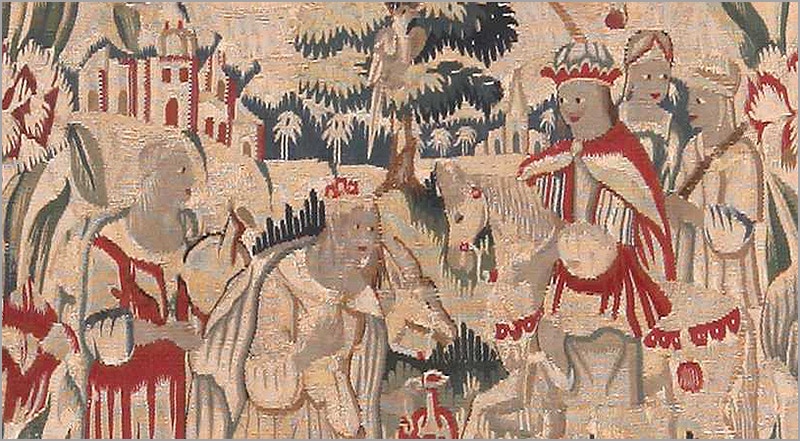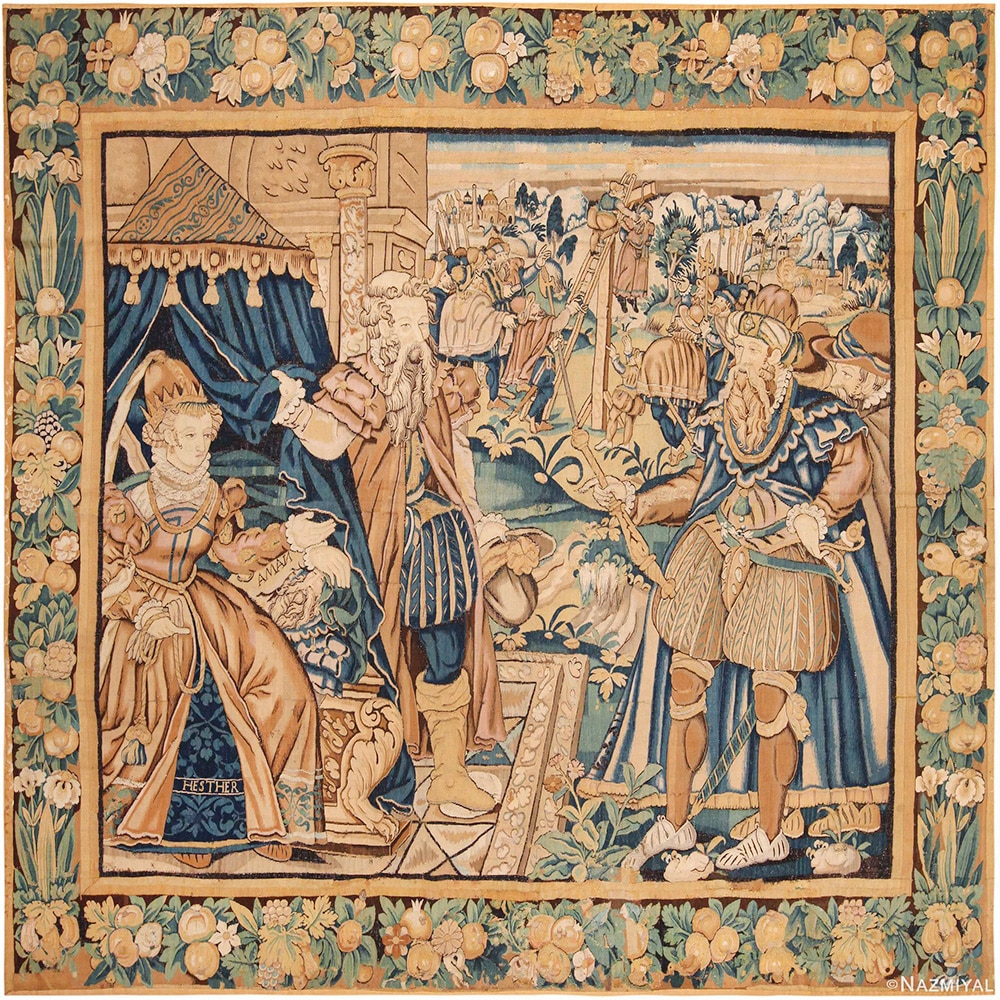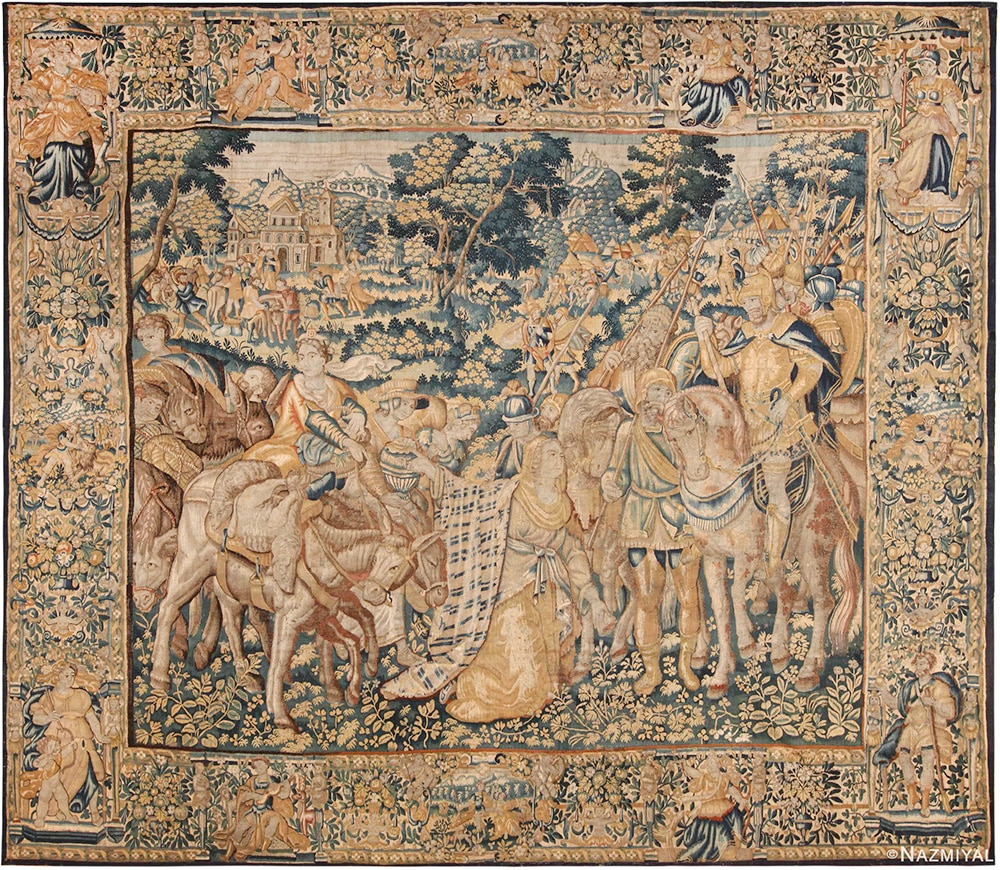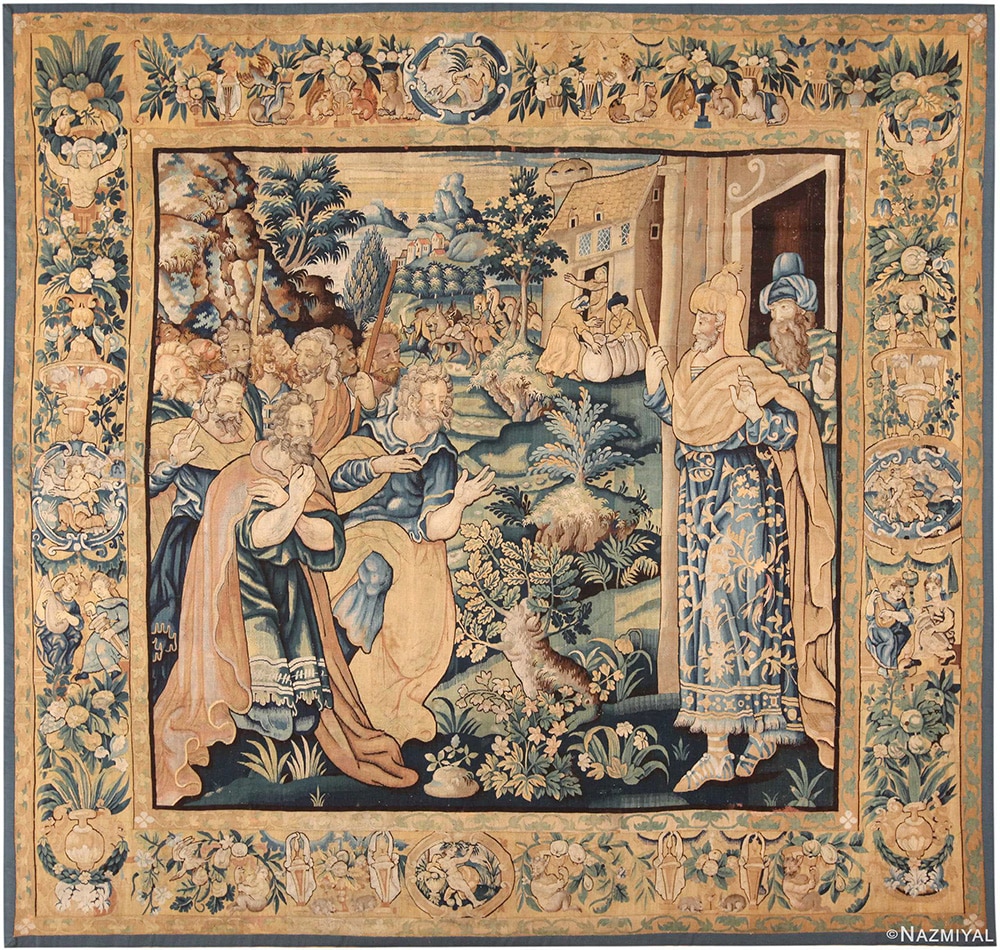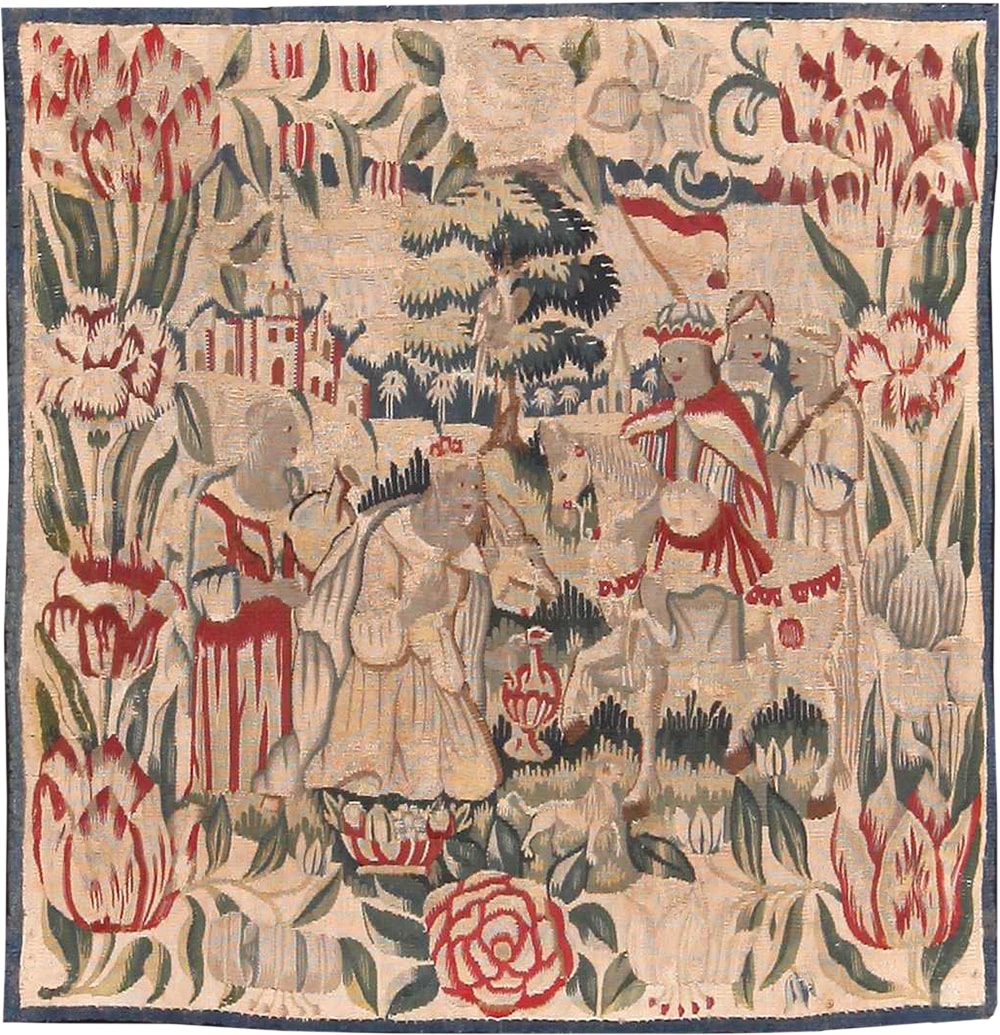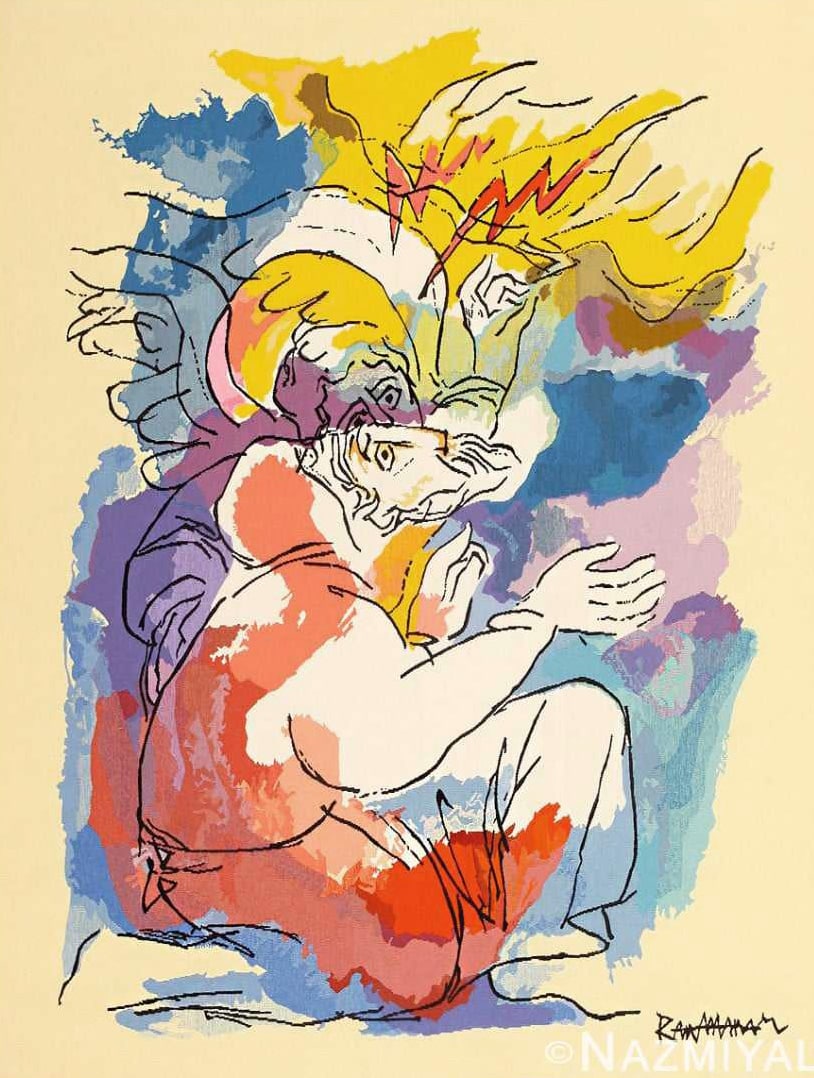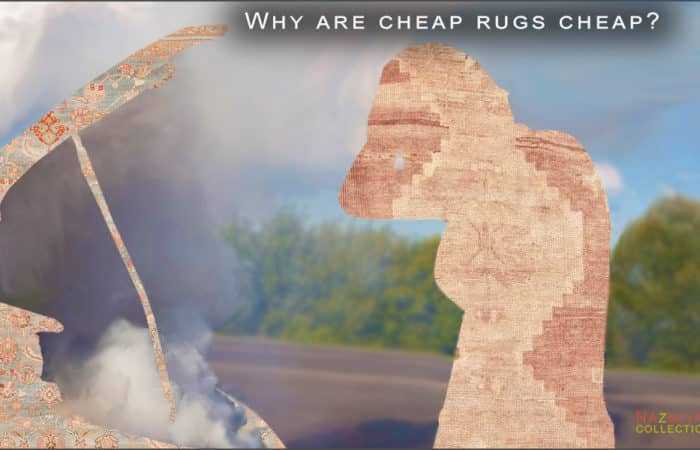The Story Behind The Creation Of Antique Biblical Tapestries
Shop Or Collection Of: Antique Tapestries | Biblical And Religious Rugs, Tapestries and Textiles | Jewish / Judaica Rugs
Learn about: Learn How To Hang A Tapestry Or Rug On The Wall | What Are Historical Tapestries? | Gobelin Tapestry History| Kesi: The History of the Chinese Tapestry | History of the Bayeux Tapestry | William Baumgarten & The Aubusson Tapestries | History of the Beauvais Tapestries | Barberini Tapestries Reborn from the Ashes | Green Tapestries Vogue 2017 Home Decor | Alighiero Boetti Tapestries | What Are The Unicorn Tapestries?
What is a biblical tapestry?
A biblical tapestry is a woven artistic wall hanging / textile art piece that depicts an image from the bible. While in this article we focus on the origins of biblical scenes in tapestries, biblical tapestries can feature depictions and talk about any of the stories from either the old or new testament. These iconic tapestries could have been woven anywhere in the world and / or from any point in time.
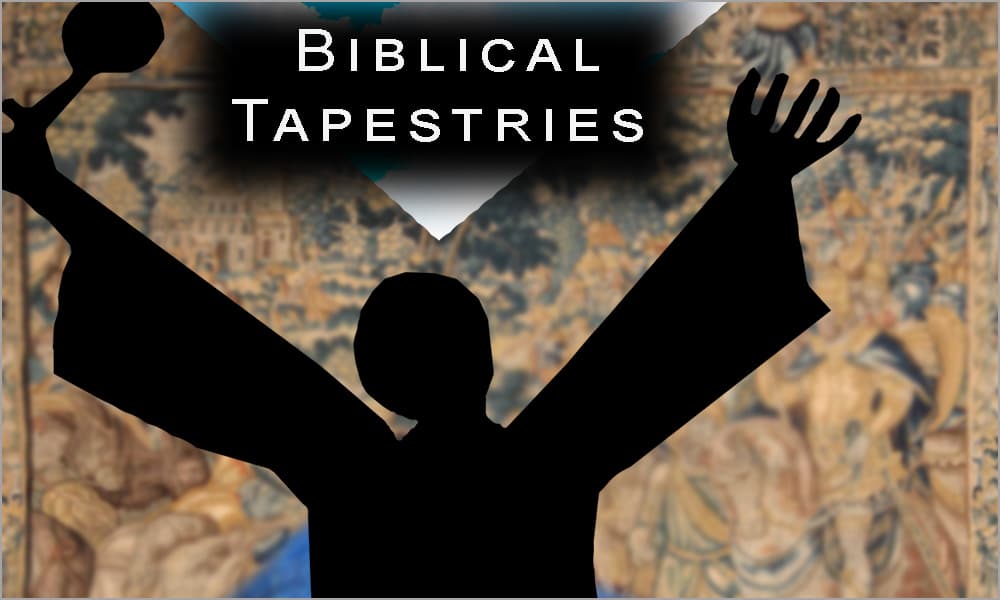
Antique Biblical Tapestries
The Beauty and Role Of Tapestries
Today, we think of tapestries as decorative items that add color or character to the space. In the past, tapestries served a much more important role in homes and the estates of noblemen. Tapestry weaving has been practiced for thousands of years, but by the 15th century, it reached new levels that continue to amaze even the casual observer. Some of the most interesting, rare and collectible tapestry artifacts are those that fall under the category of historical and religious / biblical tapestries.
The Merging Of Netherland and Italian Tapestries by Bernaert van Orley
During the early part of the 16th century, the Italian Renaissance began to have a significant influence on the arts. Artist Bernaert van Orley was one of the first to merge elements of the Netherlands tapestry tradition with elements taken from Italian design cartoons. The result was the realistic and highly decorative landscape detail of the Netherlands schools combined with scenes that represented physical or emotional drama as seen in the Italian Schools.
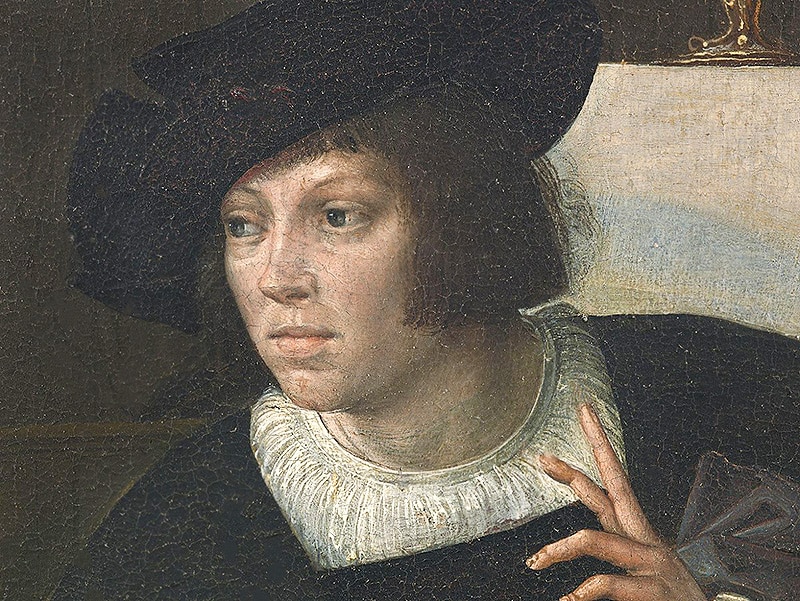
Self Portrait Of Bernard Van Orley
One of the first is a biblical tapestries that was design by Bernard van Orley and more than likely woven by Pieter de Pannemaker ca. 1525–28, probably for the duke of Alba, in a magnificent tapestry which is currently housed at Metropolitan Museum Of Art and titled – “The Last Supper”.
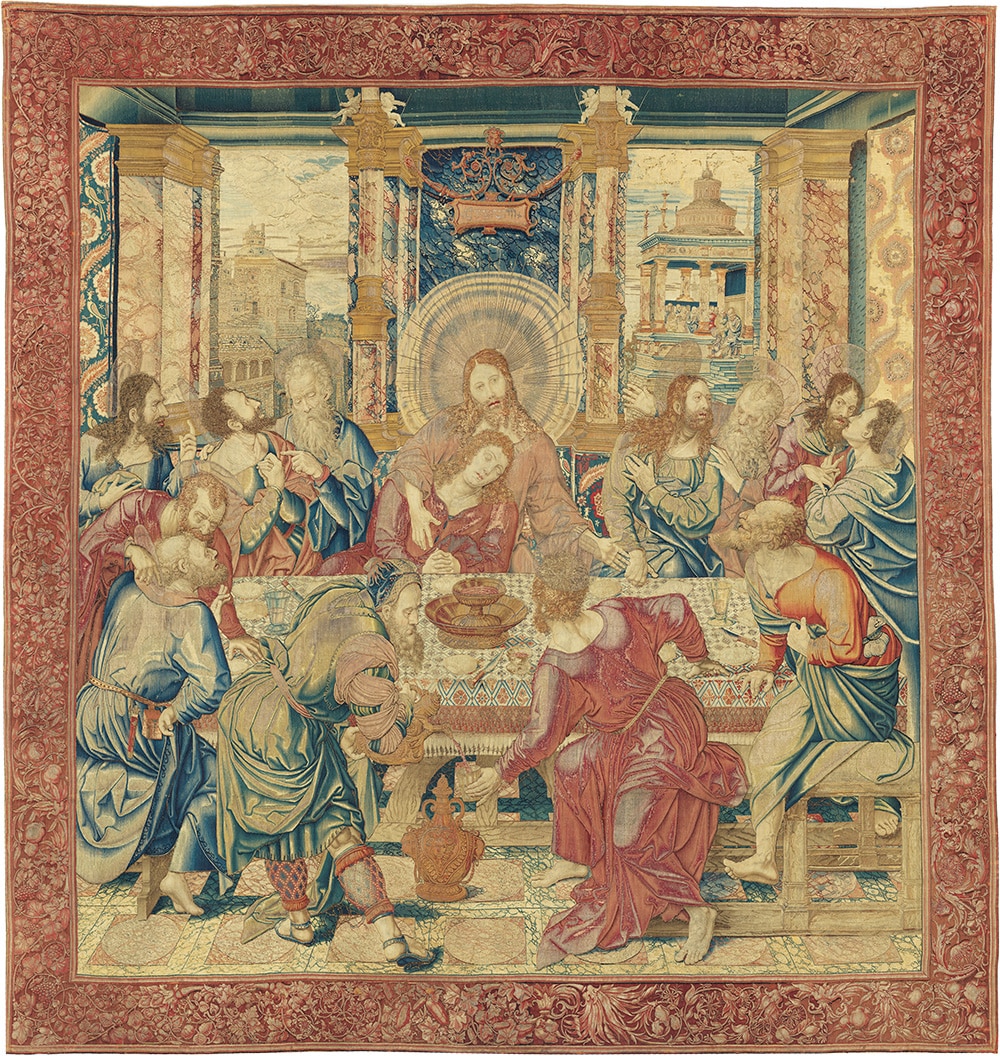
Met Museum Antique Bernard Van Orley Tapestry Of The Last Supper
Commissioning and the business of biblical theme tapestries
Tapestry commissions with biblical and religious themes became a lucrative business by the mid-16th century. The designs and religious theme tapestries also became increasingly ambitious. The themes continued to build upon and diverge from the earlier examples by artists such as Raphael and van Orley.
Now patrons began to ask the artists to include references that might suggest an association between themselves and the subject matter. The tapestry weavers naturally complied, as they needed to fulfill to these custom weaving orders from their wealthy patrons.
One example of this is a tapestry from a set of scenes that depict the Story of Diana. It is believed to have been made for the Chateau of Anet, which was the residence of French noblewoman Diane de Poitiers, who was one of Henry II’s mistresses near Paris France. The “Diana tapestries” are believed to have been the work of designer Jean Cousin the Elder between 1547-1559 and possibly woven in one of the prominent workshops in the area.
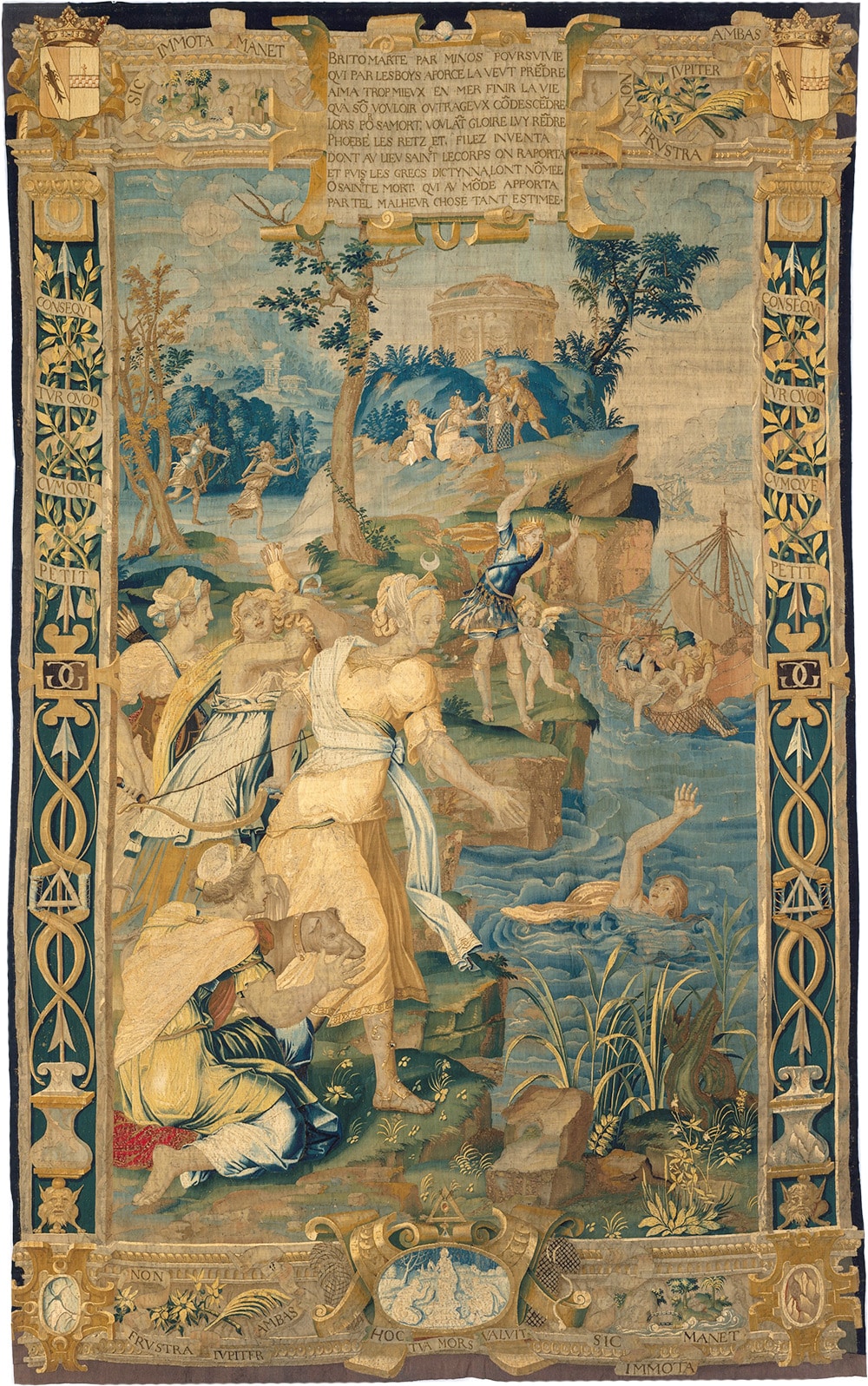
Met Museum – “Story Of Diana” Chateau Of Anet Tapestry
French noblewoman Diane de Poitiers was named after Diana, and the figure of “Diana” in the tapestry has an uncanny resemblance to the physical features of this famous royal mistress. The tapestry that portrays Diane de Poitiers as Diana seems to present the idea that the classical era had returned to Paris, but the intent was to glorify the contemporary figure.
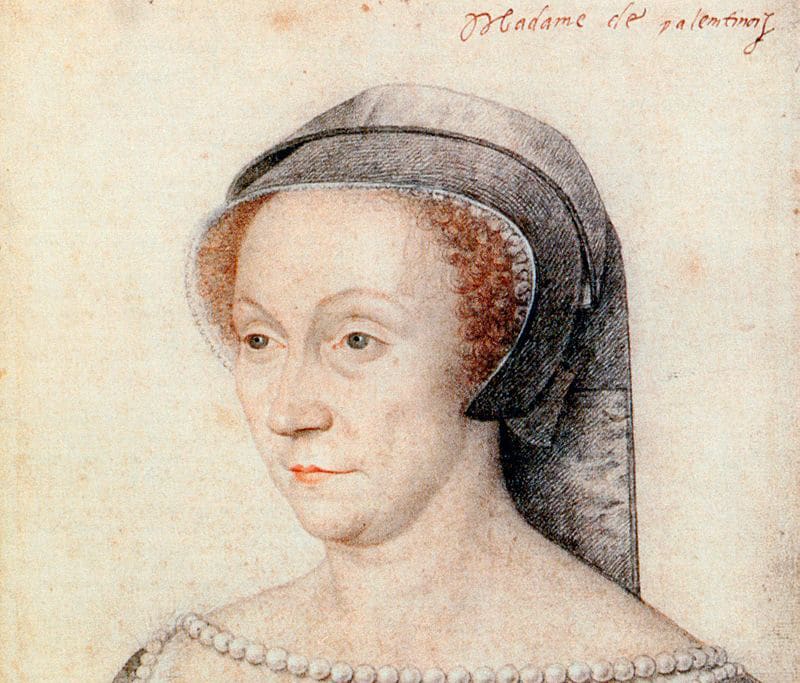
French Noblewoman Diane De Poitiers
In some cases, the artist took liberties and included elements that were not in the original story. For instance, in the scene where Britomartis decides to drown herself rather than succumb to the advances of Minos, Diana decides to use fishnets to retrieve the body so that Britomartis can be buried with the honor she deserves for her bravery. In the tapestry, we see Minos standing with his arms outstretched in anger or surprise at what he has just witnessed.
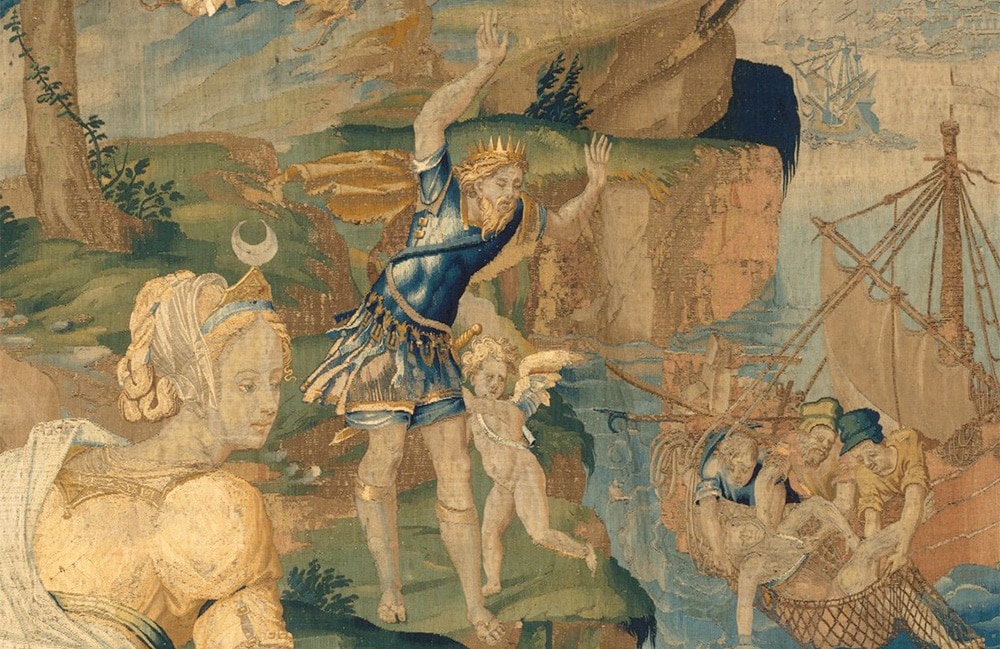
Minos standing With His Arms Outstretched in Anger
On the right, men are fishing the body of Britomartis from the water, and further in the background, Diana hands a net to two men. In the left background, Minos pursues Britomartis before the drowning scene in the foreground. The artist took great pains to make sure the audience understood the story that was represented.
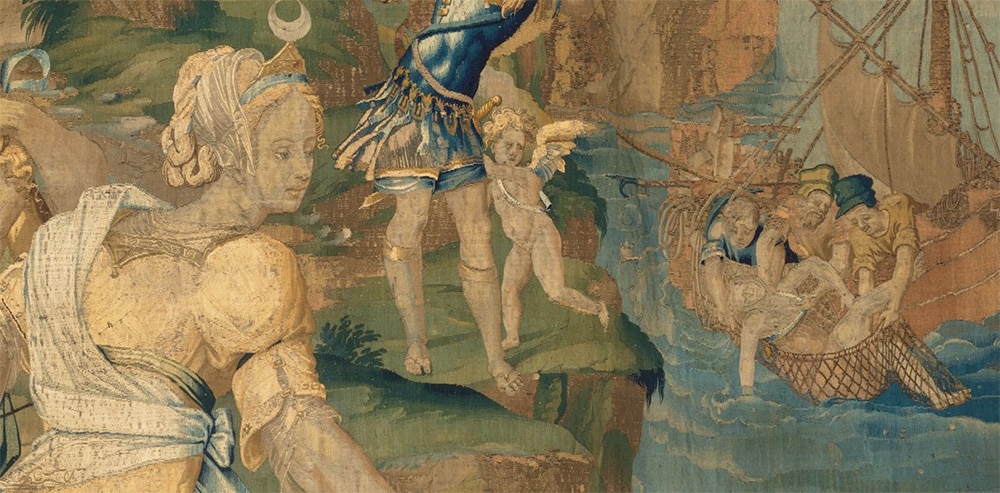
Diana Uses Fishnets To Retrieve Britomartis Body To Be Buried With Honor
Even though this story is from classical literature and not Biblical, it is an excellent example of how the tapestry artists used traditional elements from the story and used them allegorically to represent contemporary people. The figures in the tapestry are not drawn in classical style but in those of contemporary 16th-century painters. The clothing is contemporary and does not match the time of the original story.
Often you can see resemblances between the characters to depictions of famous people of the time. We must remember that the artist was working for the person who commissioned the works, and it represents the ideas of the patron not the artist per-se. In this scene, Diana is portrayed as a hero who made certain Britomartis was buried with honor. Perhaps, this was meant to convey that Diane de Poitiers was a character of honor, too.
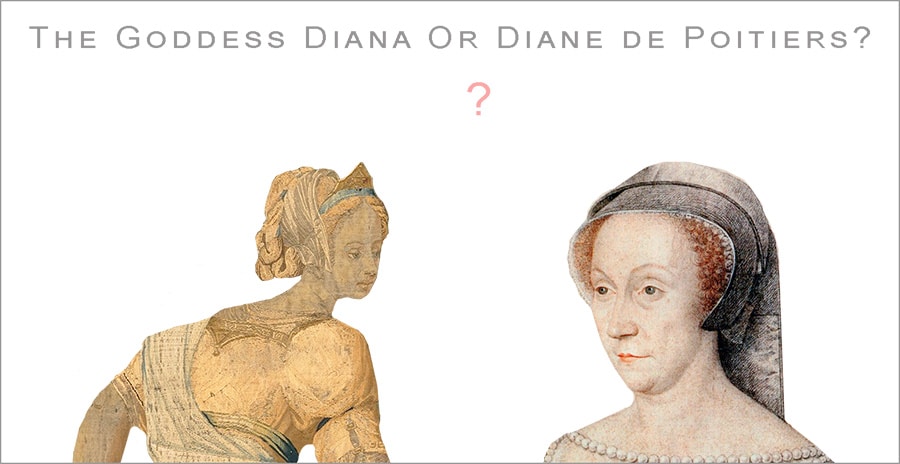
The Goddess Diana Or Noblewoman Diane de Poitiers ?
Theme and Controversy
In the beginning, many of the themes were conservative. They were beautiful pieces that often depicted idyllic scenes from daily life. From 1516-1521, a set of tapestries was created that was titled, “Act of the Apostles.” They were commissioned by Pope Leo X and woven from based on the full scale design cartoons that were created by the famous painter, Rafael (Raffaello Santi).
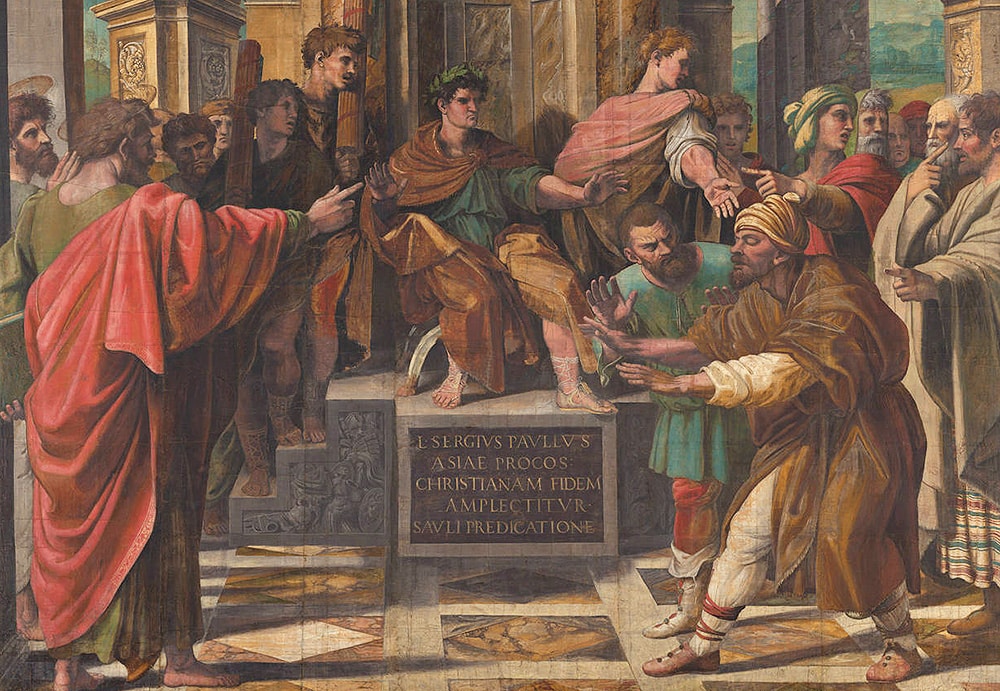
Raphael Cartoon For The Tapestry – The Conversion of The Proconsul The Blinding Of ElymasThese religious tapestries were in the form of an enormous woven fresco with life size figures in realistic and imagined settings.

Full Scale Drawing Raphael Cartoon – The Miraculous Draft of Fishes Tapestry
While the artistry of Raphael and the weavers were not controversial, Raphael included iconography and clues within the work that established Pope Leo X’s position as a representative of Christ on earth. This was one of the first tapestries to serve as an allegory for someone of authority. This religious tapestry set established the Raphael School and would alter the course of tapestry design in the years to come.
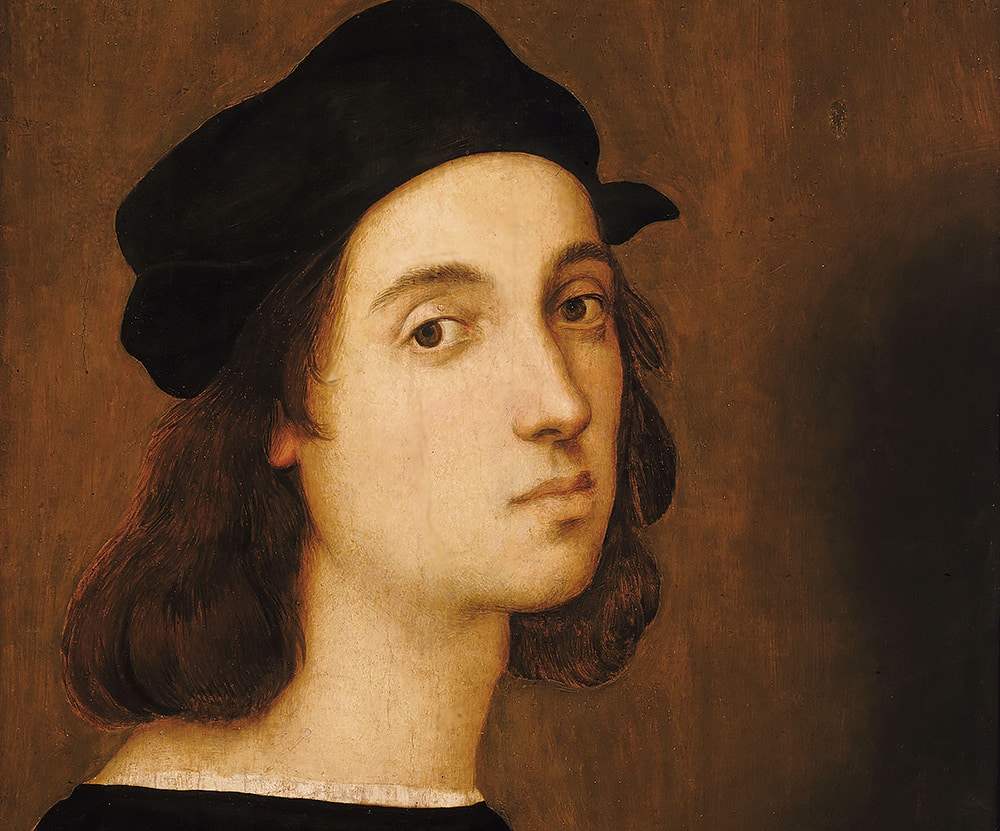
Portrait Of The Iconic Painter and Artist Raphael (Raffaello Santi)
Public Figures and Allegorical Biblical Tapestries
The story of Diana is an early example of the idea of using well-known stories to convey an idea about a contemporary person and / or time. Soon after this tapestry was created, it became common practice, often using Biblical figures and religious themed characters who bore more than a slight resemblance to public figures of the time. In many cases, the figure represented is not painted in a light that is necessarily a compliment. These tapestries sometimes exalt the characters, and sometimes, they serve as a means of political satire and criticism.
By the 1560’s, religious persecution caused many Flemish tapestry weavers to relocate, and many of them found their way to Germany. They continued to express their support and dislike of certain leaders and public characters. Many of these characters have been identified, and use the same iconography found in paintings of the time.
Here are some examples of historical biblical tapestries of the time you might look for
David and Charles V
One example of this is the portrayal of King David in scarlet or green clothing, often wearing a gold crown. The story of David and Abigail is one of heroism on the part of Abigail and reconciliation. One of the most iconic tapestries in this category depicts the moment when Abigail meets David and his troops, offering food and goods while begging for her people to be spared.
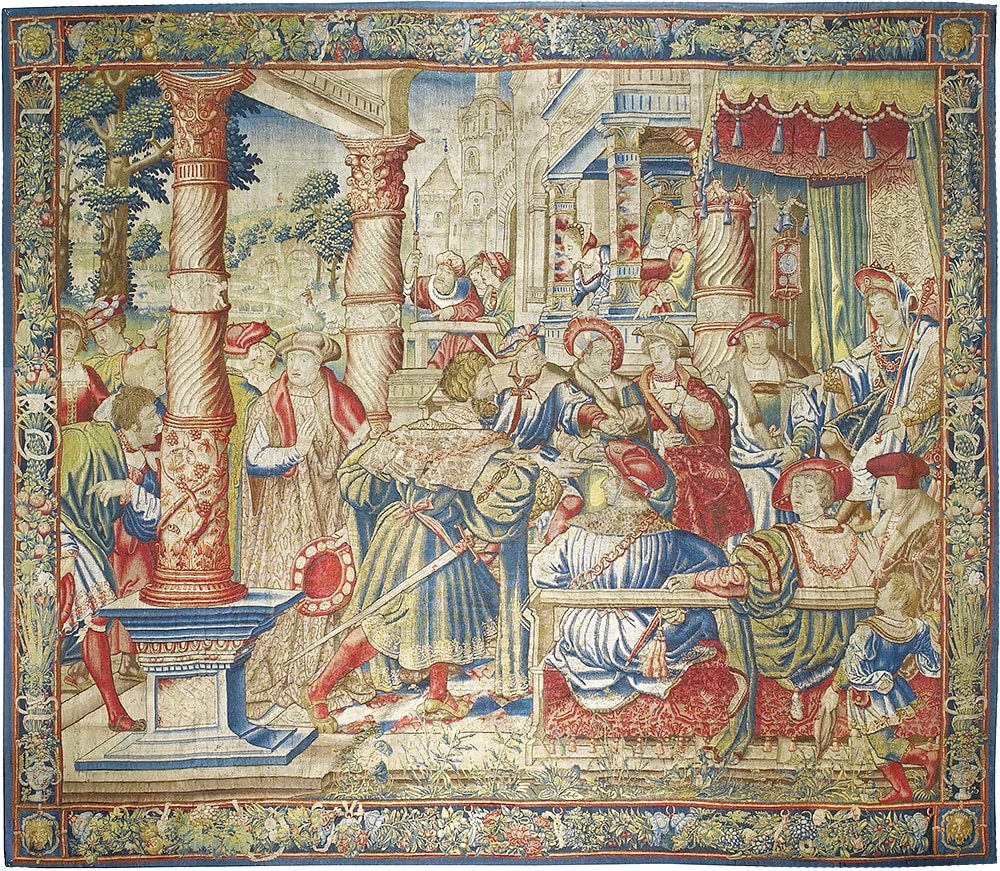
Biblical Flemish Tapestry (Charles V as) King David and Bathsheba
David is thought to be a representation, and criticism, of King Charles V. In this tapestry, David is about to commit an act of war that is unjustified, serving as a criticism of the war-like nature of Charles V.
Esther and the Queens
One of the best examples of biblical tapestries are the “Esther Tapestries, ” commissioned by Duke Philip the Bold from 1363 to 1404. The tapestries are beautiful and impressed upon the viewer the power and authority of the Duchy.
The tapestries were inspired by the Book of Esther and particularly depict representations of Duke Philip the Good and Duke Charles the Bold. In the tapestry of the wedding ceremony, the central figure draws a parallel between Esther and Margaret of York.
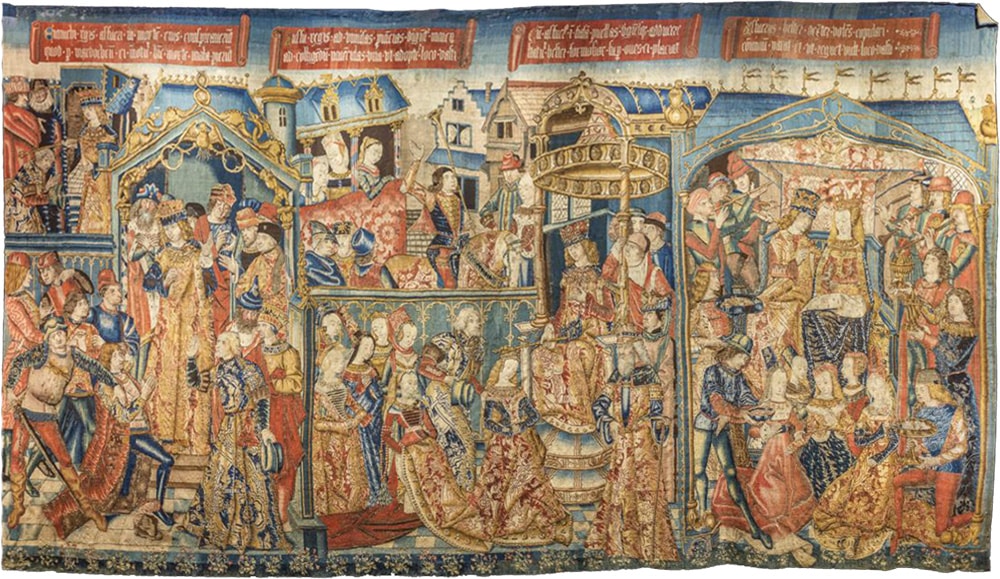
Esther Tapestry Commissioned by Duke Philip The Bold at Museo De Tapices De La Seo Zaragoza
Another tapestry in this series depicts the story of Esther and Mordecai. In this tapestry, the figure of Esther bears an uncanny resemblance to Catherine of Aragon. The first clue is the red hair of Esther. The second is that in iconography, Catherine of Aragon is often represented by pomegranates and the rose.
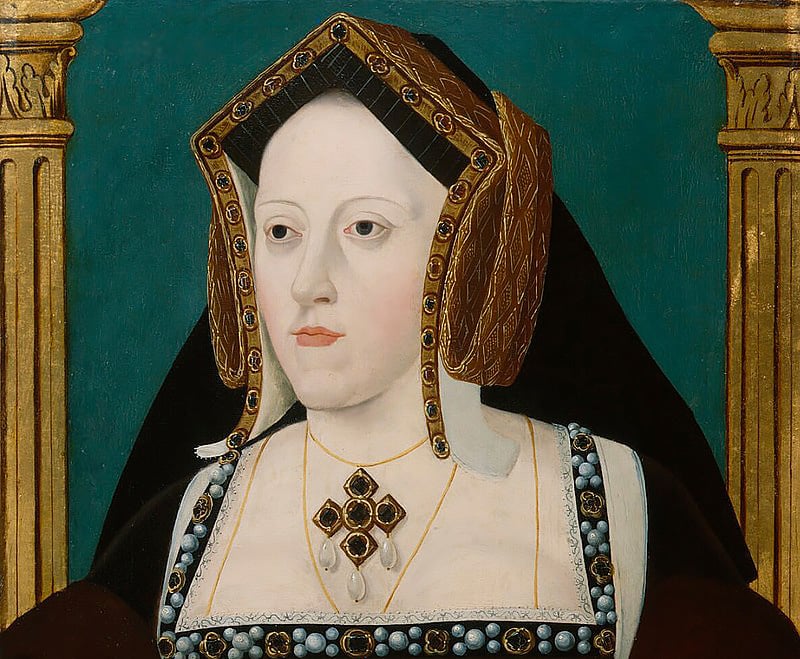
Catherine of Aragon Portrait
The border of this tapestry is filled with pomegranates, with an occasional rose. The sleeve of the man in the tent reads, “Aman,” which in Arabic means honest, faithful, and trustworthy. This tapestry compares the Godliness of Catherine of Aragon to that of Esther.

Esther Of Catherine Of Aragon?
Understanding Iconography
The study of iconography in medieval art gives a deeper understanding of the artwork and its context. Many scholars have devoted their works to uncovering the hidden meaning of these symbols. Here are a few of the symbols you might look for to give you clues to the story behind the story in Biblical tapestries and paintings.
Tudor Rose
The Tudor Rose is a five-petaled in red and white. It represents the House of Tudor and the period of peace and unity following a lengthy and destructive civil war.
Tudor Rose Tapestry Icon
Burgundian Goblet
The Burgundian Goblet is another symbol you will find in tapestries. It symbolizes the time when the Burgundian court occupied Brussels and their goblets were a symbol of power. In real life, these goblets were red and made from fine-cut glass, encrusted with pearls, and ornate gold decorative work.
Burgundian Goblet Tapestry Icon
They often had a lid with a crown on top. In tapestries and paintings, any time you see a red goblet of any type, it might reference the power of the Burgundians or a Burgundian monarch.
King Solomon and the Queen of Sheba
King Solomon is seen as wise and fair. Often Solomon is pictured with a short beard and clues to the current monarch of the time. Artists of the middle ages often ignored references that indicated the Queen was African. She often takes on a resemblance to popular female figures of the time.
Her appearance in Biblical tapestries often represents the Church and the idea that all wisdom and power come first through submission to God.
The Virgin Mary
The Virgin Mary is often represented with a cape and tunic, typically in blue or red. Blue represents divinity and the heavens, and red represents blood or humanity. Female figures in this type of clothing, even if it is contemporary to the times, draw a connection between the person and the qualities of Mary.

Antique Met Museum Virgin Mary Tapestry With The Annunciation
Mary was seen as a connection between the heavens and earth, which represented the church and state. A globe is another symbol connected with Mary and references this connection in medieval art.
Christ
The representation of Christ comes in many forms throughout medieval art. Christ has been represented by a fish, eagle, peacock, lion, deer, ostrich, ant, phoenix, ram, pelican, and unicorn. Actual representations of Christ as a human figure were banned during the 16th century.
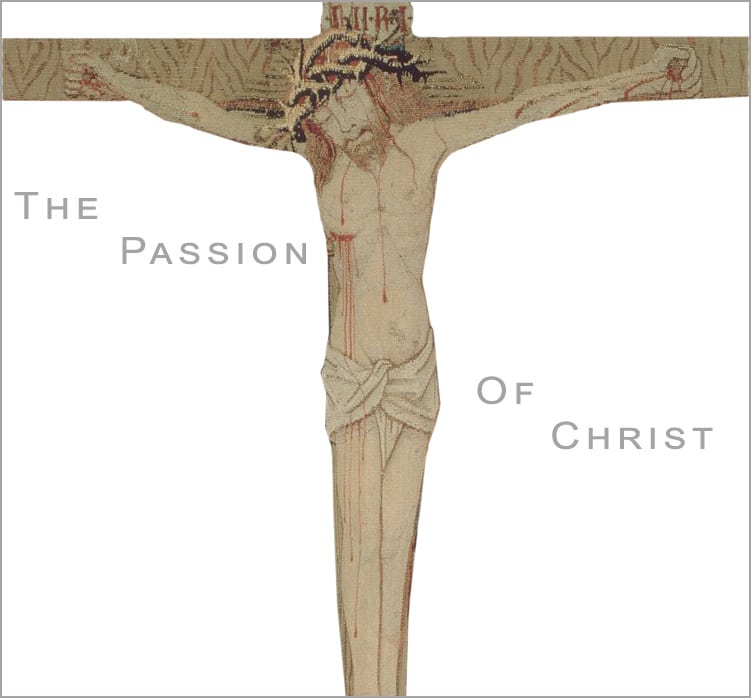
Met Museum Antique “The Passion Of Christ” Tapestry
The lamb is another common representation of Christ. Look closely at tapestries that feature animals or another iconography that can give you a clue as to the contemporary figure represented alongside one of these symbols of Christ, particularly hunting scenes.
Queen Elizabeth
You can spot representations of Queen Elizabeth by the inclusion of pearls, representing chastity and a connection to Cynthia, the Greek goddess of the moon. Mermaids represent Elizabeth’s strength against the Spanish navy. A globe symbolizes Queen Elizabeth and her connection to the symbolism of the Virgin Mary.
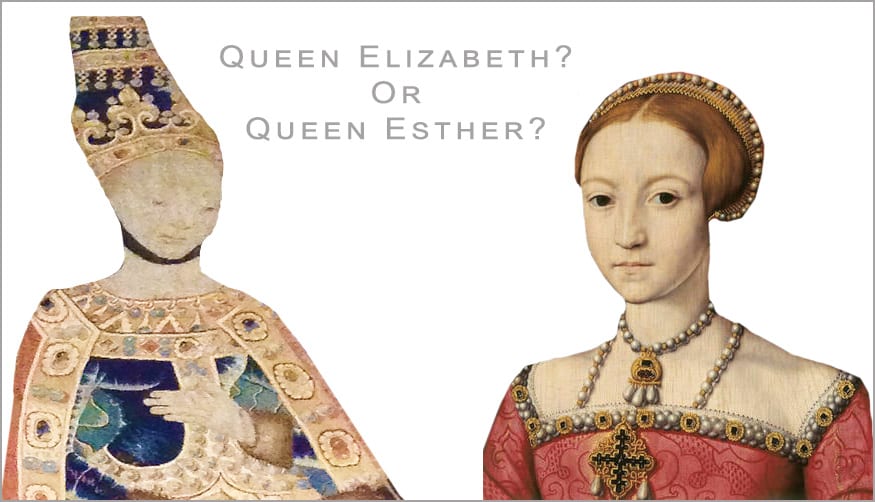
Queen Esther Or Queen Elizabeth 1?
Her iconic hair and ruff represent the brilliance of the sun and is seen in the Esther tapestry mentioned earlier. Queen Elizabeth is also represented by her iconic black-and-white color scheme, which symbolized chastity and constancy. She is a popular figure in Biblical tapestries.
Artistry Beyond Utility
The most ancient tapestries were undoubtedly for utilitarian purposes. Their thick wool and silks served as protection from the elements. Throughout the early middle ages, large-scale tapestries served as insulation to keep the drafts out of palaces and public buildings. They were also easy to transport. By the 15th century, France and the Netherlands had risen to become a leader in the tapestry weaving industry. Many of the large works were commissioned by patrons and carried out by skilled artists and craftsmen.
The tapestry works in France and the Netherlands produced pieces that could measure as much as 15-30 feet in length. In some cases, pieces of this scale were created in sets of 10 or more that carried out a particular theme. From the 15th-18th centuries, many places would establish tapestry works, such as Germany and Italy, but France and the Netherlands continued to set the standard in both quality and design.
Tapestry designers took their cues from contemporary painters of the time in theme, design, and technique. As a result, many of these pieces were quite realistic in their portrayal of the people and places. The latter portion of the 15th century marked a transformation in the art of tapestry weaving. At that time, Brussels was the center of the Burgundian court, and they managed to gain a monopoly on the tapestry industry. The Burgundians established Guilds and could reproduce the effects found in paintings by using a cartoon as a pattern.
Nazmiyal’s Biblical Tapestry Collection
These are only a few examples, and you can find many more. At Nazmiyal Gallery, we are fortunate enough to have a selection of these early Biblical tapestries in our collection. When you experience one in person, the scale and detail of them are outstanding, but once you understand that there is more behind the scenes when it comes to the subject matter, they are even more fascinating. We encourage you to explore our collection and try to guess what message the patron was trying to convey. Any of them would make a special addition to your collection or for public display.
This post about the iconic and historical biblical tapestries was published by Nazmiyal Rugs

